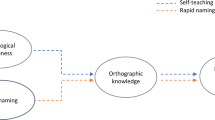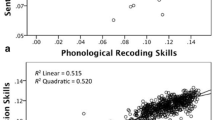Abstract
Children’s skill at recoding graphemes to phonemes is widely understood as the driver of their progress in acquiring reading vocabulary. This recoding skill is usually assessed by children’s reading of pseudowords (e.g., yeep) that represent “new words.” This study re-examined the extent to which pseudoword reading is, itself, influenced by orthographic rimes (e.g., eep) of words of the child’s reading vocabulary, during the development of reading skill. In Study 1, children with word reading levels of 6–10 years read matched pseudowords that do and do not share an orthographic rime with words of their reading vocabularies. Study 2 was conducted to further examine such a comparison for children of the 6- to 8-year word reading levels. There was a small and constant advantage of shared lexical orthographic rimes for children with reading levels 6–8 years but from 8 to 10 years that advantage increased significantly, as expected by Ehri’s phase account of word reading development. The pseudoword reading of children learning to read English involves use of lexical orthographic components as well as context-free recoding of graphemes to phonemes. This implies a qualification to the common interpretation of pseudoword reading as a measure of context-free grapheme–phoneme recoding. Such a measure should use selected pseudowords that do not share orthographic rime units or other multigrapheme components with words of the children’s reading vocabularies.
Similar content being viewed by others
References
Andrews, S. (1997). The effect of orthographic similarity on lexical retrieval: Resolving neighborhood conflicts. Psychonomic Bulletin and Review, 4, 439–461.
Berndt, R. S., Reggia, J. A., & Mitchum, C. C. (1987). Empirically derived probabilities for grapheme-to-phoneme correspondences in English. Behavior Research Methods, Instruments, & Computers, 19, 1–9.
Bernstein, S. E., & Treiman, R. (2004). Pronouncing novel graphemes: The role of consonantal context. Memory & Cognition, 32, 905–915.
Bowers, J. S., Davis, C. J., & Hanley, D. A. (2005). Interfering neighbours: The impact of novel word learning on the identification of visually similar words. Cognition, 97, B45–B54.
Bowey, J. A., & Hansen, J. (1994). The development of orthographic rimes as units of word recognition. Journal of Experimental Child Psychology, 58, 465–488.
Bowey, J. A., & Underwood, N. (1996). Further evidence that orthographic rime usage in nonword reading increases with word-level reading proficiency. Journal of Experimental Child Psychology, 63, 526–562.
Calhoon, J. A., & Leslie, L. (2002). A longitudinal study of the effects of word frequency and rime-neighborhood size on beginning readers’ rime reading accuracy in words and nonwords. Journal of Literacy Research, 34, 39–58.
Delbridge, A., Bernard, J. R. L., Blair, D., Butler, S., Peters, P., & Yallop, C. (Eds.), (2001). The Macquarie dictionary (Rev. 3rd ed.). Sydney, Australia: Macquarie Library, Macquarie University.
Ehri, L. C. (1999). Phases of development in learning to read words. In J. Oakhill & R. Beard (Eds.), Reading development and the teaching of reading (pp. 79–108). Oxford, England: Blackwell.
Franklin Electronic Publishers. (1991). Language Master, QLM-2200. Mt. Holly, NJ: Author.
Frederickson, N., Frith, U., & Reason, R. (1997). Phonological assessment battery. Windsor, Berks, UK: NFER-Nelson.
Gilmore, A., Croft, C., & Reid, N. (1981). Burt word reading test: New Zealand revision. Wellington, New Zealand: New Zealand Council for Educational Research.
Jackson, N. E., & Coltheart, M. (2001). Routes to reading success and failure: Toward an integrated cognitive psychology of atypical reading. New York: Psychology Press.
Laxon, V. J., Coltheart, V., & Keating, C. (1988). Children find friendly words friendly too: Words with many orthographic neighbours are easier to read and spell. British Journal of Educational Psychology, 58, 103–119.
Laxon, V., Masterson, J., Gallagher, A., & Pay, J. (2002). Children’s reading of words, pseudowords, pseudohomophones, and other nonwords. Quarterly Journal of Experimental Psychology, 55A, 543–565.
Laxon, V., Masterson, J., Pool, M., & Keating, C. (1992). Nonword naming: Further exploration of the pseudohomophone effects in terms of orthographic neighbourhood size, graphemic changes, spelling-sound consistency, and reader accuracy. Journal of Experimental Psychology: Learning, Memory and Cognition, 18, 730–748.
Laxon, V., Smith, B., & Masterson, J. (1995). Children’s nonword reading: Pseudohomophones, neighbourhood size, and priming effects. Reading Research Quarterly, 30, 126–144.
Leslie, L., & Calhoon, A. (1995). Factors affecting children’s reading of rimes: Reading ability, word frequency, and rime-neighborhood size. Journal of Educational Psychology, 87, 576–586.
Montant, M., & Ziegler, J. C. (2001). Can orthographic rimes facilitate naming? Psychonomic Bulletin & Review, 8, 351–356.
Powell, D., Plaut, D., & Funnell, E. (2006). Does the PMSP connectionist model of single word reading learn to read in the same way as a child? Journal of Research in Reading, 29, 229–250.
Reynolds, M., & Besner, D. (2004). Neighbourhood density, word frequency, and spelling-sound regularity effects in naming: Similarities and differences between skilled readers and the dual route cascaded computational model. Canadian Journal of Experimental Psychology, 58, 13–29.
Rosenthal, R., & Rosnow, R. L. (1985). Contrast analysis: Focused comparisons in the analysis of variance. Cambridge, UK: Cambridge University Press.
Rosenthal, R., & Rosnow, R. L. (1991). Essentials of behavioural research: Methods and data analysis (2nd ed.). New York: McGraw Hill.
Share, D. L. (1995). Phonological recoding and self-teaching: Sine qua non of reading acquisition. Cognition, 55, 115–149.
Stanback, M. L. (1992). Syllable and rime patterns for teaching reading: Analysis of a frequency-based vocabulary of 17,602 words. Annals of Dyslexia, 42, 196–221.
Thompson, G. B., & Fletcher-Flinn, C. M. (2006). Lexicalised implicit learning in reading acquisition: The Knowledge Sources theory. In C. M. Fletcher-Flinn & G. M. Haberman (Eds.), Cognition and language: Perspectives from New Zealand (pp. 141–156). Bowen Hills, Queensland, Australia: Australian Academic Press.
Thompson, G. B., Fletcher-Flinn, C. M., & Cottrell, D. S. (1999). Learning correspondences between letters and phonemes without explicit instruction. Applied Psycholinguistics, 20, 21–50.
Treiman, R., Goswami, U., & Bruck, M. (1990). Not all nonwords are alike: Implications for reading development and theory. Memory & Cognition, 18, 559–567.
Treiman, R., Kessler, B., Zevin, J. D., Bick, S., & Davis, M. (2006). Influence of consonantal context on the reading of vowels: Evidence from children. Journal of Experimental Child Psychology, 93, 1–24.
Treiman, R., Mullennix, J., Bijeljac-Babic, R., & Richmond-Welty, E. D. (1995). The special role of rimes in the description, use, and acquisition of English orthography. Journal of Experimental Psychology: General, 124, 107–136.
University of Essex, UK, Department of Psychology (2002, Autumn). Children’s printed word database. Retrieved October 15, 2004, from http://www.essex.ac.uk/psychology/cpwd.
Woodcock, R. W. (1987). Woodcock reading mastery tests – revised. Circle Pines, MN: American Guidance Service.
Woodcock, R. W., & Johnson, M. B. (1989). Woodcock-Johnson tests of achievement – revised. Itasco, IL: Riverside Publishing.
Ziegler, J. C., & Goswami, U. (2005). Reading acquisition, developmental dyslexia, and skilled reading across languages: A pycholinguistic grain size theory. Psychological Bulletin, 131, 3–29.
Acknowledgements
This research was supported by School of Psychology funds, Australian Catholic University, Melbourne. We are grateful to Sheree Chappel, Elisa Hughes, and Brydie Huggins for their contribution in administration of the tasks and initial data analysis. We acknowledge with gratitude the cooperation of the school authorities, staff, and children throughout these studies.
Author information
Authors and Affiliations
Corresponding author
Appendices
Appendices
Rights and permissions
About this article
Cite this article
McKay, M.F., Thompson, G.B. Reading vocabulary influences in phonological recoding during the development of reading skill: a re-examination of theory and practice. Read Writ 22, 167–184 (2009). https://doi.org/10.1007/s11145-007-9106-6
Received:
Accepted:
Published:
Issue Date:
DOI: https://doi.org/10.1007/s11145-007-9106-6




